River Food Webs (overview)
Current Research
- Scaling from molecules to ecosystems—Cladophora epiphytes as a model microbiome
- Climate-driven tipping points for alternate states in food webs
- Rivers–
- Meadows
- Managing invasive vertebrates in riverscapes via geomorphic and life history bottlenecks
- Predictive Mapping: How changing productivity and disturbance regimes structure salmon-supporting food webs down a river network
- Cross-ecosystem exchange
- Mainstem – Tributaries
- River – Estuary
- River – Aerial
- River – Forest
Scaling from molecules to ecosystems—Cladophora epiphytes as a model microbiome
Cladophora is the dominant filamentous green algae in the Eel River (and in temperate waters worldwide) (Fig 1). Its rough “skin” of cellulose-rich cell walls becomes colonized by many microorganisms and small animals called epiphytes. In a 2022-2027 NSF “Rules of Life” project led by Jane Marks (a Northern Arizona University professor and Angela alumna), we are examining the microbiome hosted on Cladophora in the Eel River. Using qSIP (quantitative stable isotope probing) and nanoSIMS (Nanoscale secondary ion mass spectrometry), NAU scientists can track growth rates of diatoms, cyanobacteria, protozoans, and other members of Cladophora’s microbiome under natural or manipulated light, flow velocity, temperature, or nutrient levels. In collaboration with Lawrence Livermore colleagues, we can also follow elements visually through the microbiome food web, as members compete with, facilitate, or eat each other. For example, Jane and colleagues at the Lawrence Livermore National Lab have used nanoSIMS to follow atmospheric nitrogen fixed by cyanobacterial endosymbionts of the diatom Epithemia, tracing N from the air into the endosymbiont, into the host diatom’s cytoplasm, then outside that cell into the microbiome matrix, and finally into neighboring diatoms that don’t fix nitrogen. Microbiome ecology has become a new frontier for biology, and rules of engagement may be easier to discover in the visible and manipulable Cladophora epiphyte microbiome than in the microbiomes of guts, mouths, or soils, where they have received more scientific attention. A goal of these studies is to scale up to predict consequences for macro-food webs that support either salmon or, alternatively, harmful cyanobacterial blooms.
Effect of winter and summer flows on the seasonal assembly of river food webs
Rivers under Mediterranean seasonality, like the Eel, experience rainy winters followed by summer drought with slowly declining baseflow. Scouring winter floods kill or export attached algae and rockbound invertebrates. Despite this direct damage, summers with large algal Cladophora proliferations (that get meters long) follow scouring winter floods, because of an indirect effect on the food web. Floods scour away an armored algal grazer (the caddisfly Dicosmoecus) that outgrows most predators by early summer. Following winters that lack scouring floods, Dicosmoecus suppress algae from the start of the summer growth season. Because Cladophora hosts highly nutritious diatoms that feed salmonids’ invertebrate prey, juvenile steelhead grow better under conditions that following winter floods. Floods could also sustain better growth conditions for Cladophora through the summer, but evidence at three scales, including an 83-year offshore record of sediment exported from the entire basin (Sculley et al. 2017), suggested that the top-down effects of floods (via predator control) outweighed bottom-up effects of rainy winters on algal growth conditions) in “big algae” summers in the Eel. (Fig. 9).
A third food web state of basin-wide concern is arising–one in which cyanobacteria overgrow edible algae in sunlit mainstems. Some of these cyanobacteria can be neurotoxic (Bouma-Gregson et al. 2018), and a concerning number of dogs have been poisoned by them in Northern California rivers. They tend to proliferate if summer flows drop below a threshold that keeps mainstem pools hydrologically connected with gently moving, cool (< 25oC) base flow. If summer baseflow drops below this critical level, warm stagnant conditions stress or kill salmonids, diatoms, and Cladophora, and some heat-tolerant cyanobacteria thrive (Power et al. 2015). Depletion of tributaries or groundwater can trigger these conditions. (Figs. 10, 11)
Impacts of climate and invasive annual grasses on meadow food webs
European annual grasses have displaced native perennial bunch grasses over 90% of their former range in California. In a long-term meadow manipulation of rainfall, Suttle et al. 2007 showed that, in a California grassland, species interactions strongly influence responses to changing climate, overturning, within 1 year, the direct climatic effects expected from the contrasting physiologies of annual versus perennial grasses. These largely arose because of the interactions of grasses with nitrogen-fixing forbs in the meadow (Fig. 12). Hill and Power (in review) discovered two important effects of native perennial bunch grasses on wandering meadow spiders, important predators in meadow food webs. A first direct effect, also documented elsewhere, was that by maintaining cooler near-ground microenvironments, native grasses extended wandering spider abundance and activity later through the hot dry summer, and deeper into adjacent meadows from forest edges. An important effect perennial grasses on spiders was mediated indirectly, through the food web. Unlike annuals, perennial grasses maintain sap flow through the late summer, sustaining leafhoppers that provide “baby food” for spiderlings. Because many of our local wolf spiders tend to shed their hatchlings in August, these soft, small prey may open an ontogenetic bottleneck, increasing the numbers of large spiders available to control herbivores through the following seasons. Our most abundant meadow grasshopper was Melanoplus devastator, which is also an important crop pest. In contrast, annual grasses, by favoring herbivores that can tolerate heat (grasshoppers and exotic katydids), may affect native perennial grasses via “apparent competition” (an indirect food web interaction of prey that share a common predator (Holt 1977)”. (Fig. 13)
Managing invasive vertebrates in riverscapes via geomorphic and life history bottlenecks
The Eel has been invaded by two aquatic vertebrates of conservation and fisheries concern. Sacramento pikeminnow, introduced in the late 1970s to Lake Pillsbury, have spread throughout the watershed and threaten native salmonids, via predation (by larger pikeminnow) and competition for food (with smaller pikeminnow). Threats from pikeminnow are expected to worsen as the river warms (Georgakakos 2018, Georgakakos et al. 2023). In addition, invasive bullfrogs threaten native frogs as well as an array of other native vertebrates, via predation by adult bullfrogs as well as adverse effects of bullfrog on native tadpoles (Kupferberg 1997). With support to Mary Power and Sarah Kupferberg from the Ca. Dept. of Fish and Wildlife, and in collaboration with CalTrout, CDFW, Stillwater Sciences, Inc., and the Eel River Recovery Project, we are investigating how bullfrogs and pikeminnow could best be managed during critical bottlenecks of their life histories, as they move through or reside in habitat ‘bottlenecks’ along the riverscape.
Predictive Mapping: Physiology to Food Webs Down River Networks
All landscapes on Earth, even on the sea floor, are sculpted and organized by river drainage networks. In order to forecast responses by landscapes and ecosystems to changes in climate, land use, or biota, ecologists must use “predictive mapping”: integrating observations and experiments across space and time to discover:
- Where ecological regimes change across landscapes or through drainage networks
- Which spatially varying environmental factors cause these changes
- How boundaries or gradients separating ecological regimes will expand, contract, or relocate with altered climate, land use or biota.
- How knowledge at local scales can help forecast consequences at larger scales of concern to society *(basin-wide, decadal).
Advanced mapping (LiDAR, satellite, drone), sensing (via sensor networks), and tracing technologies (genes, isotopes, mobile tracking devices) enable increasing documentation of ecological changes over space (Power et al. 2005, Bode et al. 2013). Maps that overlay ecological process rates and controls onto landscapes, in combination with field experiments that detect shifts in controlling mechanisms, should reveal whether shifts in biota or ecological interactions through space and time involve ecophysiology of individual species, or more complex ecosystem interactions. Our Eyes on the Eel research is one effort to understand food web controls over larger space and time scales.
Climate and human-driven tipping points for alternate states in river and meadow food webs
Global change is altering climate regimes across the Earth. Will organisms respond according to their physiological tolerances, or will their fates depend on shifts in interaction webs in which they are embedded? Large, permanently protected natural reserve sites have been critical to the large-scale, long-term experiments needed to address this issue. At the Angelo Reserve, we have studied how climate change will affect food webs in sunlit, mainstem rivers (1988 to present) and in grassland meadow ecosystems (2000 to present). In both habitats, organismal physiology would not explain how precipitation regimes will alter their abundance and performance in food webs.
Understanding how food webs work and shift with environmental change should help us restore and sustain the Eel to sustain ecosystem states we prefer.
Cross-ecosystem exchange
While ecosystems are often circumscribed for study at habitat boundaries (e.g. land/water or marine/freshwater interface), many if not most important ecological interactions occur across ‘ecotones’ at habitat boundaries. In our systems, we have found that rivers export algae and adult aquatic invertebrates that are tracked by terrestrial consumers, including spiders, lizards, and bats (Power et al. 2004). Sunny, warm, productive mainstems can supply emergence that subsidizes growth of spiders and juvenile spiders residing in less productive tributaries (Power and Uno 2018, Uno 2020). Drift algae, when exported from rivers to the estuary, is devoured by marine isopods and amphipods so rapidly that it disappears—suggesting that these exports represent a hitherto unrecognized trophic subsidy that may matter to estuarine and nearshore food webs (Betts-Ng 2013). Year-to-year variation in the abundance of epiphytic freshwater diatoms to the deep marine canyons off the mouth of the Eel correspond to the interannual abundance patterns of the macroalgal hosts of these diatoms upstream.
The scales of ecosystem exchanges are sometimes surprisingly large, and crucial to keep in mind when we consider repercussions of changes in one part of a connected world. Gabe Rossi is spearheading a study of the Eel River “FoodScape”—expanding his detailed studies of how juvenile steelhead foraging and growth potential respond to seasonal changes in flow and food phenology in tributaries (Rossi et al. 2022). Gabe (Fig. 14) and his team are now studying the food webs supporting salmonids from tributaries down through mainstems and into the Eel estuary. In collaboration with colleagues, we are also considering feeding in river floodplains, which are scarce along the canyon-bound Eel, but likely of outsized importance to fish. FoodScape studies investigate the seasonal occurrence of resource pulses down the river network; factors that determine whether fish can track these feeding opportunities; and how we might manage watersheds to increase access of rearing salmonids to seasonally shifting feeding opportunities.
Ecology and Conservation Biology of river-breeding frogs
California’s river breeding foothill yellow legged frog (Rana boylii), is frequently encountered 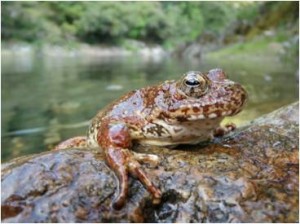 when visitors to the Angelo Reserve walk along the banks of the South Fork Eel River. These sun-loving frogs bask on rocks and jump into the water at the sound of footfall. The population at the Angelo Reserve is robust, but this species is generally in decline, especially in the southern part of its range and where it occurs near large dams. Field observations and experimental manipulations
when visitors to the Angelo Reserve walk along the banks of the South Fork Eel River. These sun-loving frogs bask on rocks and jump into the water at the sound of footfall. The population at the Angelo Reserve is robust, but this species is generally in decline, especially in the southern part of its range and where it occurs near large dams. Field observations and experimental manipulations  conducted by Sarah Kupferberg at the Angelo Reserve since 1990 have enhanced our knowledge of this species’ adaptations for survival and its vulnerabilities when humans alter rivers by building dams and reservoirs and diverting stream flows.
conducted by Sarah Kupferberg at the Angelo Reserve since 1990 have enhanced our knowledge of this species’ adaptations for survival and its vulnerabilities when humans alter rivers by building dams and reservoirs and diverting stream flows.
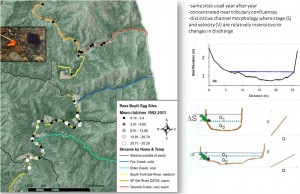 During the spring breeding season, adult frogs migrate from the narrow shady tributaries like Fox and Elder Creek where they avoid winter floods, to wide shallow cobble bars on the margins of the sunlit South Fork Eel and Tenmile Creek. Because each female lays one clutch of eggs, the total number of egg masses serves as a proxy for the size of the population. Long term monitoring has revealed that several physically-based factors influenced by variation in streamflow may impair the ability of populations to produce new recruits. By studying the population of Angelo Reserve, Sarah and her colleagues have determined that changes to flow velocity and river stage during egg incubation which result in scour or desiccation influence the number of clutches found three years later, when that cohort of tadpoles would have matured into frogs ready to lay eggs for the first time.
During the spring breeding season, adult frogs migrate from the narrow shady tributaries like Fox and Elder Creek where they avoid winter floods, to wide shallow cobble bars on the margins of the sunlit South Fork Eel and Tenmile Creek. Because each female lays one clutch of eggs, the total number of egg masses serves as a proxy for the size of the population. Long term monitoring has revealed that several physically-based factors influenced by variation in streamflow may impair the ability of populations to produce new recruits. By studying the population of Angelo Reserve, Sarah and her colleagues have determined that changes to flow velocity and river stage during egg incubation which result in scour or desiccation influence the number of clutches found three years later, when that cohort of tadpoles would have matured into frogs ready to lay eggs for the first time.
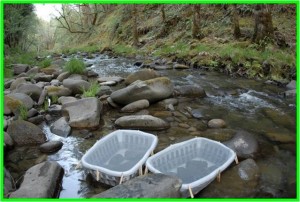 Along with colleague Alessandro Catenazzi, Sarah reared tadpoles in enclosures the various streams on the Angelo Reserve, some warm and some cool, to quantify the extent to which water temperature and quality of algal food resources influence tadpole survival, growth and development. The results of these experiments are being used to inform dam management decision making where hypolimnetic releases from upstream reservoirs occur. Cold water released can slow embryonic development and thus extend the period of desiccation / scour risk; cool summer temperatures also decrease survival, decrease size, and increase time to metamorphosis. To reduce these mortality agents, in association with engineer Scott McBain, Sarah has developed a spreadsheet model to predict the hydrologic and thermal mechanics of breeding timing, embryonic and larval development. The model integrates knowledge of individual ecophysiological and behavioral responses to water temperature with channel morphology and stage discharge relationships. When applied to three different regulated rivers in California (Trinity, Tuolumne, and Alameda Creek) the model predicted that the effects of cooler summer temperatures on tadpoles may have more profound impacts than spring flow fluctuation effects on clutches of eggs.
Along with colleague Alessandro Catenazzi, Sarah reared tadpoles in enclosures the various streams on the Angelo Reserve, some warm and some cool, to quantify the extent to which water temperature and quality of algal food resources influence tadpole survival, growth and development. The results of these experiments are being used to inform dam management decision making where hypolimnetic releases from upstream reservoirs occur. Cold water released can slow embryonic development and thus extend the period of desiccation / scour risk; cool summer temperatures also decrease survival, decrease size, and increase time to metamorphosis. To reduce these mortality agents, in association with engineer Scott McBain, Sarah has developed a spreadsheet model to predict the hydrologic and thermal mechanics of breeding timing, embryonic and larval development. The model integrates knowledge of individual ecophysiological and behavioral responses to water temperature with channel morphology and stage discharge relationships. When applied to three different regulated rivers in California (Trinity, Tuolumne, and Alameda Creek) the model predicted that the effects of cooler summer temperatures on tadpoles may have more profound impacts than spring flow fluctuation effects on clutches of eggs.
Phenology and photo-documentation of common aquatic insects in the Eel River
Shelley Pneh

Aquatic insects are some of the most abundant organisms in a freshwater river community. Most aquatic insects live under water as larvae (eating, growing and maturing), then metamorphose as flying adults,whose jobs are to disperse and reproduce. Many aquatic insects emerge synchronously, in large numbers over a short period of time.

Shelley studied emergence patterns of several common mayfly (Ephemeroptera), caddisfly (Trichoptera), moth (Lepidoptera), and true flies (Diptera) found along an eight kilometer reach of the South Fork Eel River at the Angelo Coast Range Reserve (Mendocino Co., CA). Notable synchronous emergence peaks were observed for Gumaga spp. (Sericostomatidae: Trichoptera) and a mayfly, Ephemerella excrucians (Ephemerellidae: Ephemeroptera) with a downstream to upstream emergence pattern. Interspecific temporal segregation was also observed between two mayfly species of Procloeon (Baetidae: Ephemeroptera). Habitat preference was also observed among sampling sites: Petrophila confusalis (Crambidae: Lepidoptera) only emerged over large stones and boulders; Heptageniid mayflies preferred emerging from flowing water and Gumaga and midges (Chironomidae) emerged in highest numbers from slow flowing water. Shelley also compared the efficiency of two different emergence traps.
Flow and climate thresholds for algal assemblages in the Eel River
Algae are foundational energy sources for food webs in sunlit rivers. Many (like most diatoms) are highly edible and fuel summer growth for fish and macroinvertebrates. Other algal taxa, however, are inedible or even toxic (harmful 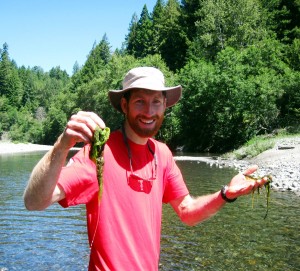 algae bloom, HAB) degrading aquatic habitats, water quality, and creating public health hazards. Keith Bouma-Gregson is working towards identifying threshold conditions that tip healthy algal assemblages into harmful algal blooms in the Eel, and similar rivers. He has partnered with the Eel River Recovery Project (ERRP, www.eelriverrecovery.org) to develop a citizen science algal monitoring program for the Eel. Keith has also collaborated with Raphael Kudela, UC Santa Cruz, to deploy Prof. Kudela’s cyanotoxin monitoring SPATT samplers throughout
algae bloom, HAB) degrading aquatic habitats, water quality, and creating public health hazards. Keith Bouma-Gregson is working towards identifying threshold conditions that tip healthy algal assemblages into harmful algal blooms in the Eel, and similar rivers. He has partnered with the Eel River Recovery Project (ERRP, www.eelriverrecovery.org) to develop a citizen science algal monitoring program for the Eel. Keith has also collaborated with Raphael Kudela, UC Santa Cruz, to deploy Prof. Kudela’s cyanotoxin monitoring SPATT samplers throughout

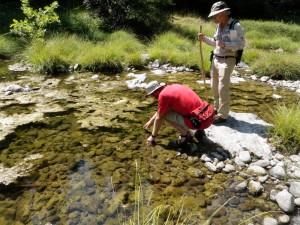
the South Fork and mainstem Eel River during summer base flow. At several sites, they detected the cyanobacterial neurotoxin, anatoxin-a. Starting in since 2002, this toxin has been implicated in the deaths of several dogs after they swam in the Eel River. Keith complements his basin-scale monitoring with local experiments and detailed monitoring of local proliferation and spread of cyanobacterial infestations. As summer flows subside, incipient growths of the potentially toxic cyanobacterium Anabaena spp. start to develop as epiphytes on senescent spires of Cladophora glomerata. Keith monitors and experimentally manipulates light, temperature, nutrients, and flow velocities to understand conditions that allow toxic cyanobacteria to overgrow and dominate the more ‘normal’ edible assemblages of diatoms that cover rocks and surfaces of green macroalgae. Where and when can changing environmental conditions flip edible algal assemblages to assemblages dominated by inedible or harmful algae?
Some climate change scenarios predict larger winter floods and drier summers, which would favor cyanobacteria proliferations. Anthropogenic water withdrawals further depress summertime river discharges, also increasing the likelihood of cyanotoxin production. Knowledge of thermal, solar radiation, and flow regimes that promote cyanobacteria is needed for management to sustain a fish-bearing food web and reduce public health hazard from cyanotoxins. Keith Bouma-Gregson is a Research Biologist at the California Water Science Center.
Tracing linkages and thresholds of food webs and ecosystems through Eel drainage networks
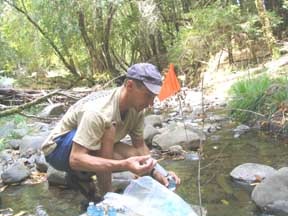
Dr. Jacques Finlay is a Professor in the College of Biological Sciences at the University of Minnesota. Jacques and his students and colleagues investigate how organisms and environments interact with biogeochemical fluxes, cycles, and transformations. He has used innovative isotope techniques to trace the sources and fate as of solutes transported by rivers, and their exchange between channels and surrounding watersheds. Jacques’ work on how flow and longitudinal changes in photosynthetic demand systematically altered stable 13C enrichment of algae paved the way for better resolution of the importance of algal versus terrestrial carbon sources for 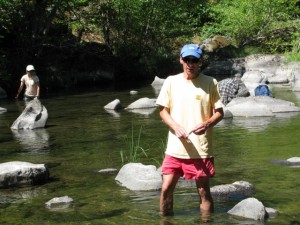 consumers in rivers. He has also detected and quantified changes in nitrogen isotopes that correspond to a longitudinal and seasonal increase in cyanobacterial nitrogen fixation in the Eel. He detected an abrupt threshold where watershed areas exceeded 100 km2, where light availability allowed increasing photosynthesis and nitrogen fixation by benthic algal assemblages, which in turn altered stream-water N concentration and N:P ratios and stoichiometry in larger streams and mainstem rivers. Jacques work has also given us glimpses of the spatial dimensions of food web interactions–organisms that co-occur within mm of each other may actually feed from different “resource sheds”. Recently, he has expanded his isotope analysis to use deuterium, and has collaborated with his former student Martin Tsui to use the strange, multiple isotopes of methyl mercury to trace energy exchange between channels and surrounding forests.
consumers in rivers. He has also detected and quantified changes in nitrogen isotopes that correspond to a longitudinal and seasonal increase in cyanobacterial nitrogen fixation in the Eel. He detected an abrupt threshold where watershed areas exceeded 100 km2, where light availability allowed increasing photosynthesis and nitrogen fixation by benthic algal assemblages, which in turn altered stream-water N concentration and N:P ratios and stoichiometry in larger streams and mainstem rivers. Jacques work has also given us glimpses of the spatial dimensions of food web interactions–organisms that co-occur within mm of each other may actually feed from different “resource sheds”. Recently, he has expanded his isotope analysis to use deuterium, and has collaborated with his former student Martin Tsui to use the strange, multiple isotopes of methyl mercury to trace energy exchange between channels and surrounding forests.
Algal ecology and taxonomy
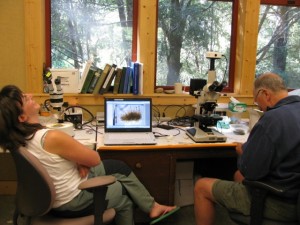
Dr. Paula Furey is an Associate Professor at the University of St. Catherine in Minneapolis, MN. Paula studies how abundances, health, and taxa of algae change over time and space. Of particular interest to her nitrogen-fixing algal species (cyanobacteria and diatoms in the family Rhopalodiaceae, which contain cyanobacterial endosymbionts), and how these shift in abundance and species composition seasonally, between different years, and down the drainage network from headwaters in to the main stem of the Eel River. Paula’s research highlights how hydrology, light, temperature, and foodweb interactions can alter species assemblage structure from edible, nutritious diatoms to less nutritious or hard to graze diatoms, or even toxin 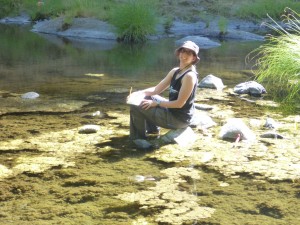 producing cyanobacteria. Her work on algae-midge interactions demonstrated that shifts in algal species composition caused by midge–algae interactions at small scales (um–m) could affect ecologically significant processes, such as nitrogen fixation and foodweb interactions at larger reach and watershed scales. She is developing a regionally relevant algal identification guide for use by researchers and local water-monitoring groups. Images taken at three scales (environmental context, macroscopic (what we’d see with the naked eye) and microscopic) will provide information key to identification.
producing cyanobacteria. Her work on algae-midge interactions demonstrated that shifts in algal species composition caused by midge–algae interactions at small scales (um–m) could affect ecologically significant processes, such as nitrogen fixation and foodweb interactions at larger reach and watershed scales. She is developing a regionally relevant algal identification guide for use by researchers and local water-monitoring groups. Images taken at three scales (environmental context, macroscopic (what we’d see with the naked eye) and microscopic) will provide information key to identification.
Algal Food Web Investigation Team (AFWIT)
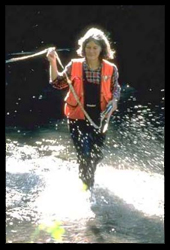
Our group studies food webs, which in our study areas are primarily fueled by attached algae. We are interested in how attributes and performances of algae and cyanobacteria, their invertebrate and vertebrate grazers, and predators of these grazers affect river, watershed, and coastal ocean ecosystems. We are particularly interested in how key species interactions change under different environmental regimes. To track this, we take advantage of Earth science research in and around our study sites in a “predictive mapping” approach, integrating across space and time to discover:
- Where and when ecological regimes change;
- Which factors cause these changes;
- How local landscape or seasonal controls are altered by changes in climate, land use or biota;
- how local interactions scale up to affect basinwide linkages of river, upland and coastal ecosystems.
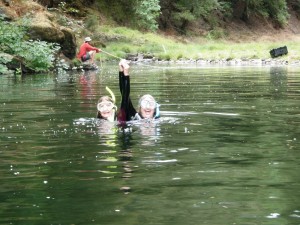
The surface area of rivers is small relative to the area of their watersheds; terrestrial plant biomass typically dwarfs that of aquatic primary producers; and gravity pulls material down slopes. For these reasons, it is oftenassumed that “forests feed their rivers”. Rapid growth and excellent nutritional quality of attached algae like diatoms, however, make them surprisingly important food sources, not only for aquatic consumers, but also for terrestrial biota like spiders, lizards, birds, and bats. We investigate process like insect emergence and algal stranding through which “the river feeds the forest”. We have recently also recently launched studies of linkages of the river to the ocean: examining the potential importance of riverine algal drift for consumers in estuaries; and whether algal-mediated biogeochemistry canaffect primary productivity in the coastal ocean near the river mouth. Mary Power is a Professor in the Department of Integrative Biology at Berkeley, and Faculty Director of the Angelo Coast Range Reserve.
Paleoproductivity of the Eel River as recorded in Eel’s marine canyon diatoms
Jack Blackburn Sculley
 Jack’s research interests centered on how food webs or ecosystems respond to climate change and to changes in disturbance regimes over decadal to century-long time-scales. Using cores sampled by Chuck Nittrouer and Tina Drexler at the University of Washington, he quantified diatom frustule (glass shells that encase cells) abundances from in a marine canyon carved at low sea stand off the mouth of the Eel River. These cores record almost 100 years of
Jack’s research interests centered on how food webs or ecosystems respond to climate change and to changes in disturbance regimes over decadal to century-long time-scales. Using cores sampled by Chuck Nittrouer and Tina Drexler at the University of Washington, he quantified diatom frustule (glass shells that encase cells) abundances from in a marine canyon carved at low sea stand off the mouth of the Eel River. These cores record almost 100 years of 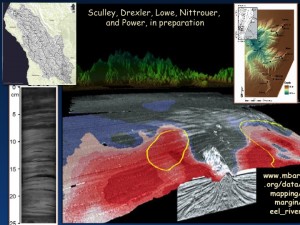 sediment deposition, with annual resolution. During 13 years when Mary Power surveyed algal abundance upstream in the modern Eel, the abundances of freshwater diatoms in core laminae correlate reasonably well with magnitudes of summer algal blooms, which tend to be larger following scouring winter floods. Jack used this marine record of freshwater diatoms, as well as marine diatoms, to evaluate how changes in river discharge and marine upwelling over annual and multi-year time scales have affected recent paleo-productivity in the linked river-coastal ocean ecosystem. Jack completed his Ph.D. in 2014 in Integrative Biology at UC Berkeley.
sediment deposition, with annual resolution. During 13 years when Mary Power surveyed algal abundance upstream in the modern Eel, the abundances of freshwater diatoms in core laminae correlate reasonably well with magnitudes of summer algal blooms, which tend to be larger following scouring winter floods. Jack used this marine record of freshwater diatoms, as well as marine diatoms, to evaluate how changes in river discharge and marine upwelling over annual and multi-year time scales have affected recent paleo-productivity in the linked river-coastal ocean ecosystem. Jack completed his Ph.D. in 2014 in Integrative Biology at UC Berkeley.
Foraging and food-web impacts of American dippers (Cinclus mexicanus) under different flow regimes
Charles Post
Charles Post studied the foraging and food-web impacts of American dippers (Cinclus mexicanus) under different flow regimes. Dippers are voracious predators on aquatic insects and small fish, but their impacts as predators in river food webs are not yet well documented. With intensive field observations of marked individuals, Charles has evaluated dipper impacts on a dominant algae grazer, Dicosmoecus gilvipes, whose heavy armor protects it from gape-limited predators like fish. Dicosmoecus populations are usually knocked back by scouring winter floods in the Eel, but when these floods don’t occur during drought, large numbers survive to graze down algae, with cascading consequences for other web members including salmonids who derive much of their energy from algal-based food webs. Charles is also investigating how flow depth, flow velocity, and substrate affect the foraging rates and choices by dippers in open and experimentally arranged river habitats. He will document their habitat use and foraging patterns over reach scales, where locations of favorite emergent boulders, nest locations, and riparian forest offset from channels all
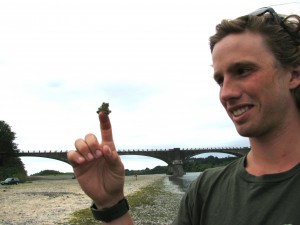
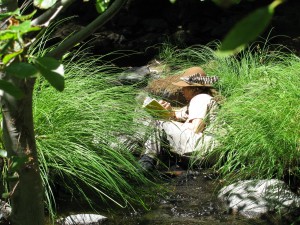
algae, with cascading consequences for other web members including salmonids who derive much of their energy from algal-based food webs. Charles is also investigating how flow depth, flow velocity, and substrate affect the foraging rates and choices by dippers in open and experimentally arranged river habitats. He will document their habitat use and foraging patterns over reach scales, where locations of favorite emergent boulders, nest locations, and riparian forest offset from channels all influence foraging patterns of dippers over larger spatial scales. His aim is to understand (1) How American dippers change their habitat use and foraging choices under different flow regimes, which vary seasonally and with year-to-year variation in rainfall. (2) How dipper impacts on dominant grazers and primary producers will differ across hydrologic regimes. These insights will inform efforts to forecast how these amazing birds and their impacts will respond to changes in climate or land cover that rivers along the North Coast will confront over the years ahead. Charles Post is a former Master’s student with Mary Power in the Department of Integrative Biology at UCB.
Physiology to food webs down river networks
Jonathon Stillman and team
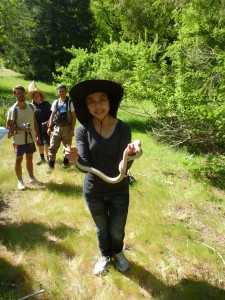
Jonathon, a professor at SFSU and in Integrative  Biology at UCB, links the physiology of invertebrates to their performances in a changing world, led a BIGCB (Berkeley Initiative Global Change Biology) team that investigated how the thermal performance of aquatic insect larvae will affect the trophic ecology of warming rivers. Larvae of insect grazers vs. predators may also differ in the efficiency with which they use energy under various thermal regimes. Metabolic energy efficiency is maximized at optimal temperatures and declines at higher temperatures due to an increase in fermentative metabolism and an induction of stress responses to cope with thermal or oxidative damage.
Biology at UCB, links the physiology of invertebrates to their performances in a changing world, led a BIGCB (Berkeley Initiative Global Change Biology) team that investigated how the thermal performance of aquatic insect larvae will affect the trophic ecology of warming rivers. Larvae of insect grazers vs. predators may also differ in the efficiency with which they use energy under various thermal regimes. Metabolic energy efficiency is maximized at optimal temperatures and declines at higher temperatures due to an increase in fermentative metabolism and an induction of stress responses to cope with thermal or oxidative damage.
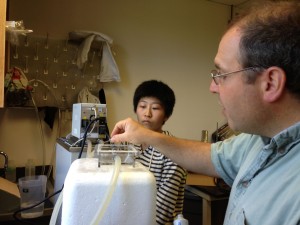
Jonathon and his team compared thermal effects on gene expression of four aquatic insects (Pteronarcys californica, Calinueria californica, Hesperoperla pacifica and Dicosmoecus gilvipes) across temperatures of the spring-summer range during late larval instar phase (~12-30°C). Illumina RNA-seq, de novo transcriptome assembly using Trinity, and analysis using Bowtie2/eXpress and EdgeR were used to identify differentially expressed genes within each species. Heat sensitive predator taxa exhibited a reduced induction of cellular stress response genes. Biomarkers of thermal acclimation from the dominant predator-resistant grazer in the Eel River, Dicosmoecus gilvipes, were used to compare across a fine-scale range of temperatures, and across populations from sites with differing thermal characteristics. These data allow a fine-scale analysis of local physiological adaptation to temperature and shifts in metabolic ecology of streams across much of the central to northern California landscape.
Mayfly migrations from mainstems to tributaries can sustain salmonids in warming river networks
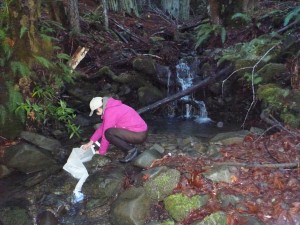 Hiromi Uno has discovered an unusual mayfly, Ephemerella macu
Hiromi Uno has discovered an unusual mayfly, Ephemerella macu lata (Ephemerellidae), whose life cycle migration may help sustain steelhead populations in the warming rivers of California. Every summer for twenty years, Angelo researchers puzzled over a mysterious phenomenon. For about a month, the pools of cool, large areas of pools in Fox Creek, a dark tributary stream near the researcher cabins, would become encrusted with dead insects. Hiromi looked more closely, and noticed that 1) they were almost all female mayflies, and 2) they were all a species, Ephemerella maculata, whose nymphs do not occur in these dark tributaries. After consulting an expert taxonomist, she was able to identify E.maculata nymphs, which are very different from the adults. She found that these nymphs only reared in the warm mainstem South Fork Eel, where they fed on abundant algae. Nymphs emerge in early summer, adult winged females mate, then swarm up dark, cool tributaries, where they plunge into white-water riffles, shed their eggs, and die. As spent mayflies drift into pools, juvenile steelhead and giant Pacific salamanders gorge themselves on their dead or moribund bodies. The egg masses, however, are not eaten, even when offered to predators experimentally. Egg masses look like small, translucent pieces of brown popcorn. They sink, stick to the stream bed, and go into a resting period (diapause) for many months, until the first winter rains, when they hatch and tiny, new nymphs are washed down into the mainstem.
lata (Ephemerellidae), whose life cycle migration may help sustain steelhead populations in the warming rivers of California. Every summer for twenty years, Angelo researchers puzzled over a mysterious phenomenon. For about a month, the pools of cool, large areas of pools in Fox Creek, a dark tributary stream near the researcher cabins, would become encrusted with dead insects. Hiromi looked more closely, and noticed that 1) they were almost all female mayflies, and 2) they were all a species, Ephemerella maculata, whose nymphs do not occur in these dark tributaries. After consulting an expert taxonomist, she was able to identify E.maculata nymphs, which are very different from the adults. She found that these nymphs only reared in the warm mainstem South Fork Eel, where they fed on abundant algae. Nymphs emerge in early summer, adult winged females mate, then swarm up dark, cool tributaries, where they plunge into white-water riffles, shed their eggs, and die. As spent mayflies drift into pools, juvenile steelhead and giant Pacific salamanders gorge themselves on their dead or moribund bodies. The egg masses, however, are not eaten, even when offered to predators experimentally. Egg masses look like small, translucent pieces of brown popcorn. They sink, stick to the stream bed, and go into a resting period (diapause) for many months, until the first winter rains, when they hatch and tiny, new nymphs are washed down into the mainstem.
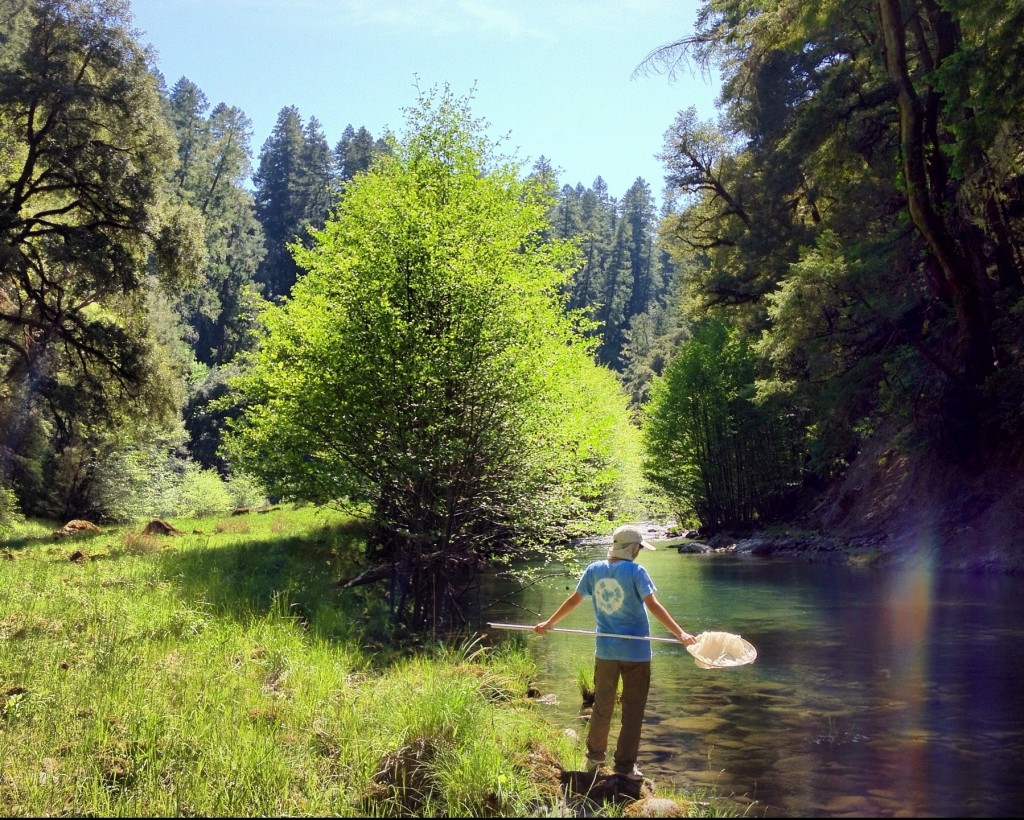
Hiromi has captured the hatching and recently hatched egg cases of E. maculata as the first winter flood of swept them down the tributary into the mainstem South Fork Eel River. This mainstem habitat warms over the spring and summer to become a productive habitat for mayfly nymphs, but stressful for cold-water steelhead trout (Oncorhyncus mykiss), which typically rear in rivers for one and half years before they migrate to the ocean. In warming rivers of Northern California, rearing juvenile steelhead are increasingly restricted to cool tributaries, where little food is produced. Hiromi’s experiments have shown that the migration of E. maculata helps sustain summer rearing by juvenile salmonids in cool tributary refuges where they would otherwise be food-limited. By transferring energy subsidies from productive mainstems to food-limited tributaries, this mayfly appears to enhance the resilience of steelhead populations in the warming rivers of northern California. Hiromi was a Ph.D. student with Mary Power in the Dept. of Integrative Biology at UCB. She is currently a JSPS Postdoctoral Fellow at Hokkaido University.
Life history of Mermithid nematode parasites of the migratory mayfly, Ephemerella maculata

Larissa Walder has worked with graduate student Hiromi Uno and invertebrate taxonomist George Poinar (Oregon State Univ.), allowing George taxonomically identify the first mermithid nematode species known to science. Mermithids are parasites of mayflies, including the migratory mayfly discovered by Hiromi Uno. Larissa and Hiromi studied the life cycle of the Mermithid nematode parasite relative to that of their migratory aquatic host, the mayfly, Ephemerella maculata. Eggs of E. maculata hatch in tributaries, then the aquatic nymphs drift downstream to mature and rear in the mainstem. In early summer, aerial adult mayflies emerge synchronously from the mainstem and return to the tributaries to lay eggs. Nematodes exit from adult mayflies after the mayflies have oviposited and drowned in the tributary. Larissa, Hiromi, and helpers collected 304 adult mayflies to measure the infection rate and the reduction in host fecundity. They also surveyed the spatial distribution and interaction of E. maculata and Mermithid nematodes across seasons. Almost half of the 304 mayflies they sampled were infected, and no infected female mayflies produced eggs, indicating the nematodes sterilize the host mayflies. Larissa sampled monthly, and found that immature nematodes emerged from host mayflies in summer when the adult mayflies oviposited. These juvenile nematodes matured outside of the host, mated, and oviposited in tributary sediments near host egg masses. E. maculata eggs hatched and the nymph mayflies drifted downstream in December/January before the nematode eggs hatched. Nematode egg masses probably wash into mainstems when winter storms flush tributaries. These ecological detectives (Larissa et al.) are still trying to figure out how, when, and where juvenile nematodes infect their nymphal mayfly hosts. Larissa graduated in 2014 with a BS from Berkeley, and is teaching high school in Oakland CA.
Transformation and bioaccumulation of mercury in tributary-mainstem networks of the Eel River
Martin Tsui
Atmospheric deposition dominates mercury in this semi-remote ecosystem. Martin is interested in using Angelo Reserve as a model to examine factors  such as canopy cover and stream productivity affect mercury cycling. Over the last 6-7 years, Martin and his colleagues have found substantial transformation of mercury in the stream network especially the downstream sections, including methylation of mercury and photo-breakdown of methylmercury, due to the high abundance of microbial communities to methylate mercury and sunlight availability to break down methylmercury, respectively. Lately, Martin has measured stable isotope compositions of mercury in food webs throughout the stream network and demonstrated that some fish (steelhead trout) and stream invertebrates (water strider) had mercury burden partially or solely from terrestrial sources in some headwater streams, implying that stable mercury isotopes can also be used as a powerful tracer for energy sources besides commonly used carbon and hydrogen stable isotopes. Right now, Martin and his group are examining the stable mercury isotope compositions in different forests across the United States and one of them is within Angelo Coast Range Reserve, and the goal is to elucidate the sources of methylmercury in forest food webs by using this novel isotope tool, and research is on-going at the moment. Martin Tsui is an Associate Professor at the University of North Carolina at Greensboro.
such as canopy cover and stream productivity affect mercury cycling. Over the last 6-7 years, Martin and his colleagues have found substantial transformation of mercury in the stream network especially the downstream sections, including methylation of mercury and photo-breakdown of methylmercury, due to the high abundance of microbial communities to methylate mercury and sunlight availability to break down methylmercury, respectively. Lately, Martin has measured stable isotope compositions of mercury in food webs throughout the stream network and demonstrated that some fish (steelhead trout) and stream invertebrates (water strider) had mercury burden partially or solely from terrestrial sources in some headwater streams, implying that stable mercury isotopes can also be used as a powerful tracer for energy sources besides commonly used carbon and hydrogen stable isotopes. Right now, Martin and his group are examining the stable mercury isotope compositions in different forests across the United States and one of them is within Angelo Coast Range Reserve, and the goal is to elucidate the sources of methylmercury in forest food webs by using this novel isotope tool, and research is on-going at the moment. Martin Tsui is an Associate Professor at the University of North Carolina at Greensboro.
